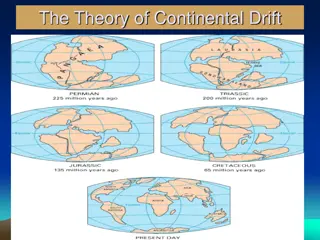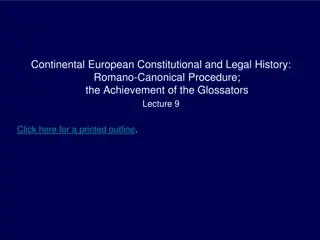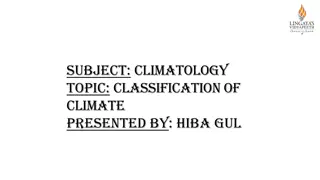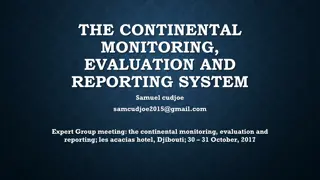Addressing Mental Health Disparities in Academia for BIPOC Individuals
Factors impacting BIPOC mental health include limited access to quality care, cultural mistrust, discrimination, stigma, and lack of awareness. BIPOC individuals in academia face additional stress due to questions about their abilities and worthiness. Historical contexts influence mental health inte
0 views • 13 slides
SUR-TOITURE ET DOUBLE TOIT
Producing shade, reducing heat flux, and saving energy through the use of double roofs and over-roofs. Double roof systems involve installing a new roof over an existing one with proper insulation, while over-roofs create a protective layer above the original roof. These techniques significantly low
1 views • 11 slides
Understanding Different Climate Types and Regions
The climate is shaped by temperature, precipitation, and wind, creating global patterns and diverse climate regions. From tropical wet climates to continental warm summers, each region has unique characteristics based on temperature and precipitation. By understanding these climate types, we can app
1 views • 7 slides
Best Affordable hotels in Udaipur
Finding Best Affordable hotels in Udaipur that doesn't compromise on quality can be a challenge. However, several budget-friendly hotels offer comfort and convenience without breaking the bank. One such gem is Hotel Florence Continental, known for its exceptional service and value for money. While H
5 views • 1 slides
Best 3 star hotel in Udaipur
In the realm Best 3 star hotel in Udaipur, Hotel Florence Continental shines as a beacon of comfort and value. This charming hotel offers a delightful blend of modern amenities and traditional Rajasthani hospitality, ensuring a memorable stay for every guest. The rooms at Hotel Florence Continental
4 views • 1 slides
Continental Drift, Theory of Tolerance & Major Biomes of the World Overview
This detailed presentation explores topics like Continental Drift, the Theory of Tolerance, and Major Biomes of the World. It covers the history of the Continental Drift theory, from Wegener to Du Toit's modifications, and delves into the various terrestrial biomes that exist, including tundra, bore
2 views • 26 slides
Adaptation of Animals to Hot Climates - Understanding Thermal Regulation Strategies
Animals have evolved remarkable adaptations to cope with hot climates, including physiological responses such as sweating and changes in body size and limb length. Temperature stress can affect their functioning, making thermoregulation crucial. Bergmann's rule and Allen's rule explain how body size
0 views • 15 slides
Unlocking Africa's Economic Potential through the African Continental Free Trade Area
The African Continental Free Trade Area (AfCFTA) aims to consolidate Africa's fragmented market, with 22 countries having populations below 10 million. By eliminating barriers, AfCFTA creates a $2.3 trillion market of 1.3 billion people, fostering market opportunities, scaling economies, improved co
6 views • 24 slides
Advancing the African Continental Free Trade Area: Opportunities and Challenges
The African Continental Free Trade Area aims to consolidate a fragmented market, capitalize on Africa's market growth, and diversify Africa's exports. With the potential to create a $2.3 trillion market of 1.3 billion people, the AfCFTA is poised to improve competition, lower business costs, and fos
0 views • 24 slides
Understanding Criminal Offences: A Comparative Analysis
Exploring the concept of criminal offences, this article delves into the definitions in common law and continental law systems. It discusses the structural elements, harmful nature, prohibition, punishment, and distinctive aspects of criminal acts. A comparison between common law and continental law
1 views • 33 slides
Understanding the Kӧppen Climate Classification System
The Kӧppen climate classification system, developed by Wladimir Kӧppen in 1884 and modified over the years, categorizes climates based on native vegetation as the best indicator. It recognizes five major climatic types designated by capital letters, reflecting temperature and precipitation pattern
0 views • 10 slides
The Theory of Continental Drift and Wegener's Evidence Explained
The Theory of Continental Drift proposes that continents were once part of a single landmass known as Pangaea, which eventually broke apart and drifted to their current positions. Alfred Wegener provided evidence supporting this theory, including the fit of continents like puzzle pieces, fossil simi
0 views • 27 slides
Analytic Versus Continental Philosophy in the 20th Century: A Comparative Overview
In 20th-century philosophy, the divide between Analytic and Continental schools deepened but has seen recent attempts at reconciliation. Analytic philosophy emphasizes logic, language, and epistemology, requiring technical expertise, while Continental philosophy rejects metaphysical speculation and
0 views • 15 slides
Overview of American Revolution Events and Key Decisions
The content provides a detailed account of significant events and decisions leading up to and during the American Revolution, including the Boston Massacre, Boston Tea Party, First Continental Congress, shot heard 'round the world, Second Continental Congress, Battle of Bunker Hill, Common Sense, an
1 views • 21 slides
Evolution of Procedural Law in Continental European Legal History
The journey of procedural law in Continental European legal history, from the challenges faced by glossators in creating Romano-canonical procedure to the discussions on canonic procedure in canon law. Explore the intricacies of legal procedure development and the influences of historical texts such
0 views • 36 slides
Understanding Biomes: Concept, Classification, and Factors
Biomes are large natural ecosystems encompassing plant and animal communities shaped by shared physical climates. They are classified based on climate, vegetation, soil-water, and heat availability, encompassing diverse environments like deserts, forests, savannas, and oceans. The concept of biomes
0 views • 6 slides
The Path to American Independence: Lessons from History
Explore pivotal moments in American history from the Continental Congress forming the Continental Army to the drafting and approval of the Declaration of Independence. Learn about key figures like George Washington, Thomas Paine, and Thomas Jefferson who played crucial roles in shaping the course of
0 views • 13 slides
The Theory of Continental Drift: Alfred Wegener and Pangaea
Alfred Wegener proposed the theory of continental drift, suggesting that the continents were once part of a single landmass called Pangaea. Evidence such as fossils and rock formations on different continents supports this theory. The concept of plate tectonics further explains the movement of conti
0 views • 6 slides
The Impact of Continental Drift on Earth's Biogeography
Continental drift, caused by the movement of tectonic plates, has had profound effects on Earth's habitats and the distribution of organisms. From the formation of supercontinents to the separation of land masses, these geological processes have led to climate change, speciation events, mass extinct
0 views • 17 slides
The Fascinating Theory of Continental Drift Explored
In the early 1900s, Alfred Wegener introduced the groundbreaking hypothesis of continental drift, suggesting that the continents were once part of a single landmass before drifting apart to their current locations. This theory is supported by evidence such as the alignment of continents, shared foss
0 views • 25 slides
Understanding Climate Classification Systems
Climatology explores the classification of climates based on vegetation distribution, average temperatures, precipitation patterns, and seasonal variations. This system categorizes climates into groups like tropical, dry, mild temperate, continental, and polar. Each group further delineates specific
0 views • 8 slides
Understanding Earth's Structure and Continental Drift Theories
Dutch mapmaker Abraham Ortelius noted the jigsaw fit of continents, leading to the theory of continental drift. Alfred Wegener proposed the movement of continents based on geological evidence, influencing plate tectonics theory. Earth's layers vary from the thick mantle to the solid inner core due t
0 views • 27 slides
Georgia's Role in the American Revolution
Explore Georgia's involvement in the Revolutionary War period, including its absence in the First Continental Congress, representation in the Second Continental Congress, the role of Georgia's Second Provincial Congress, and the challenges faced during the Revolutionary War fighting in Georgia again
0 views • 10 slides
The Theory of Plate Tectonics: Continents in Motion
Earth's crust and lithosphere have changed over geologic time, forming tectonic plates that move due to convection currents. The concept of plate tectonics explains how continents fit together, the existence of a supercontinent called Pangaea, and natural phenomena like earthquakes and mountains. Ea
0 views • 28 slides
Overview of Central America: Landforms, Climates, People, and Cultures
Central America, an isthmus connecting North and South America, comprises seven countries with diverse landforms and climates. The region features mountainous cores, Caribbean lowlands, and Pacific coastal plains, each with unique characteristics. The population is a mix of indigenous peoples, Europ
0 views • 10 slides
Understanding Global Climates and Ireland's Climate
Explore the concept of climate, classification of global climates, and factors influencing Ireland's cool temperate oceanic climate. Learn about different climate types such as hot, temperate, and cold climates, and how Ireland's proximity to seas and oceans affects its weather patterns. Discover th
0 views • 16 slides
The Road to Independence: Second Continental Congress and Military Actions Overview
The chapter delves into the pivotal events following the Second Continental Congress, including the drafting of the Olive Branch Petition, the American attack on Fort Ticonderoga, and the significant Battle of Bunker Hill. Despite British victory, this battle marked a moral triumph for the American
0 views • 18 slides
Triumph and Sacrifice: The Continental Army in The Winter of Red Snow
The soldiers and Continental Army depicted in the movie "The Winter of Red Snow" were resilient, courageous, and determined as they faced the challenges of the Revolutionary War. Despite the hardships, including the Wyoming Massacre, with French aide, they eventually achieved victory at Yorktown, ma
0 views • 12 slides
The Road to Revolution: Actions of Parliament and Continental Congress
The events leading to the American Revolution, including the actions of Parliament and the Continental Congress, are highlighted in this chapter. It covers the issues facing the 2nd Continental Congress, the differences between Patriots and Loyalists, the failure of the Olive Branch Petition, and th
0 views • 21 slides
Understanding Sediment Dispersion along the Continental Margin
This content explores the influences and types of sediment dispersion systems along the continental margin. Processes affecting sediment supply, depositional environments, and different dispersal systems like Estuarine Accumulations Dominated and Marine Dispersal Dominated are discussed. Walsh and N
0 views • 8 slides
Understanding Air Pressure, Air Masses, and Fronts in Earth Science
Explore the concepts of air pressure, air masses, and fronts in Earth Science. Learn about the influence of high and low-pressure systems, isotherms, pressure centers, global winds, the Coriolis Effect, and how air masses like continental and maritime affect weather patterns. Discover the impact of
0 views • 24 slides
Understanding Deserts and Desertification: Lecture Insights by Maher M. Mahdi
Delve into the world of deserts and desertification with valuable insights collected by Maher M. Mahdi. Explore definitions of deserts, steppe regions, and semi-arid climates. Learn about the dryness ratio, distinguishing factors between true deserts and semi-deserts, and Budyko-Lettau dryness ratio
0 views • 22 slides
Exploring Geography: Processes, Climates, and Development in Different Places
Explore the interconnectedness of different places through the lens of globalization, climate variations, physical processes, hydrology, coasts, development, and sense of place. Delve into topics like population changes, economies, landscapes, and climates of countries such as Russia, Iceland, Kenya
0 views • 4 slides
Exploring Earth's Structure and Continental Drift
Delve into the fascinating layers of the Earth, including the crust, mantle, and core, while understanding how rocks are classified and the processes of weathering, erosion, and rock formation. Discover the concept of continental drift through evidence such as fossil similarities and geological form
0 views • 10 slides
Evaluation of 0.706 87Sr/86Sr Line as Marker for North American Continental Edge
Palinspastic restoration analysis challenges the suitability of the 0.706 87Sr/86Sr line as a definitive indicator for the edge of North America. Findings suggest a suture zone west of the line and question its role in delineating the continental margin based on rock compositions and distribution in
0 views • 6 slides
Effective Strategies for Communication and Reporting in Continental Monitoring & Evaluation
Strategies for effective communication and reporting in the Continental Monitoring, Evaluation, and Reporting System are outlined, emphasizing the importance of engaging stakeholders at both country and continental levels. Initiatives include generating public awareness, outreach efforts, and levera
0 views • 23 slides
The Theory of Continental Drift and Plate Tectonics
Scientist Alfred Wegener proposed the theory of continental drift, noticing how continents could fit together like pieces of a puzzle. His idea evolved into the concept of plate tectonics, explaining the movement of Earth's lithosphere. This model highlights the dynamic nature of the Earth's surface
0 views • 4 slides
Contrasting Legal Reasoning in Common Law and Continental Law Systems
This inaugural lecture explores the differences in legal reasoning between judges on both sides of the English Channel. It delves into the declaratory theory of decision-making in Common Law and the application of legislative intent in Continental Law. The lecture also touches on the contrasting ind
0 views • 48 slides
Exploring the Wonders of Oceania's Islands
Delve into the captivating world of Oceania's diverse islands, from continental to volcanic formations. Understand the unique characteristics of Micronesia, Melanesia, and Polynesia, home to over 20,000 islands. Explore the differences between continental islands, like New Guinea and New Caledonia,
0 views • 16 slides
Continental Challenges: A Decade of Progress in Internet Infrastructure
This overview delves into the evolving landscape of internet challenges and solutions over the past 10 years across multiple continental regions. It examines the persistence of challenges, the emergence of new obstacles, and the growth of international internet bandwidth to Africa. Additionally, it
0 views • 10 slides







































